And always remember to C# or you'll Bb!
Pedal Steel Guitar Tunings

*You are welcome to copy and share these photo
charts and everything on this website.
Pedal Steel Guitar Tunings
*You are welcome to copy and share these photo charts and everything on this website.
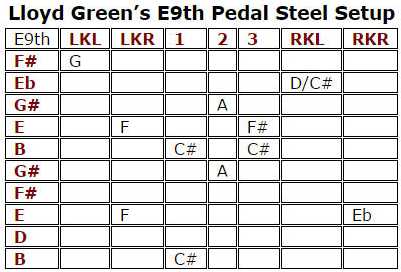
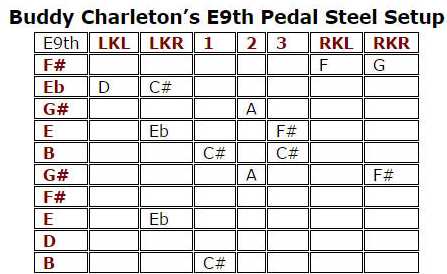
*ABOVE: Lloyd Green, what can you say, he's my favorite pedal steel artist, bar none. Truly, “Simplicity is the heart of elegance” (a quote from Lloyd). Lloyd often uses the change on string one that raises F# to G. Lloyd has pioneered many new steel sounds. Buddy Charleton's change lowering string one from F# to F is very interesting.
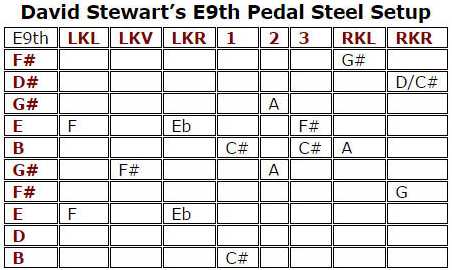
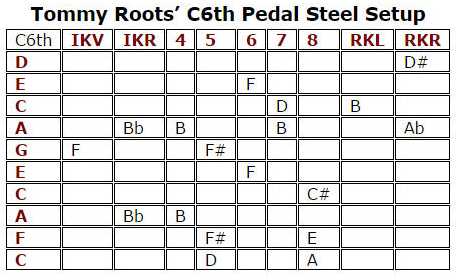
*ABOVE: I use Tommy White's change lowering strings 5 and 6 individually, which sounds awesome.
*BELOW: I admire Tommy White's setup. In an attempt to keep it simple, I don't lower string 10 anymore, because it
made the knee too tight. I've often contemplated just putting Lloyd's setup on my E9th, but I really love Tommy White's change that individually lowers strings 5th and 6th. Note: On guitars with a split-tuning feature on the 6th string, it won't work unless you use a plain string. I've been using a wound .026" like Lloyd, and it won't allow me to obtain a split-tuning because of the physics involved. I think the wound string has a more distinctive tone.
Tommy Roots was one of my favorite C6th performers. I met him in Saint Louis at a ISGC in the early 1990's.
Click here to hear & learn how to play 'Stardust' and 'The Shadow Of Your Smile.'
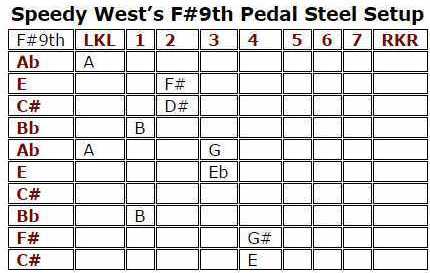
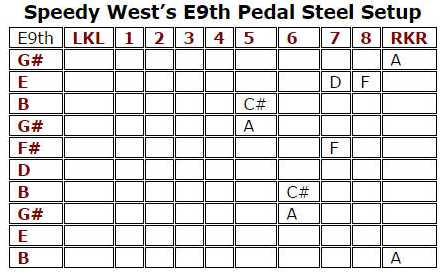
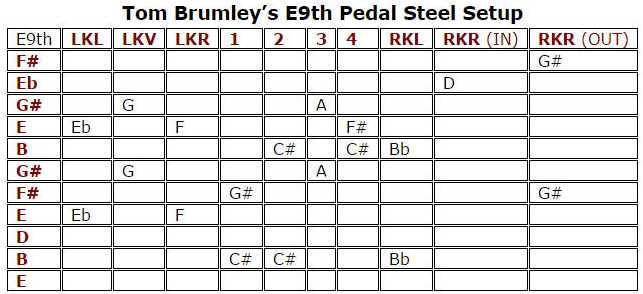
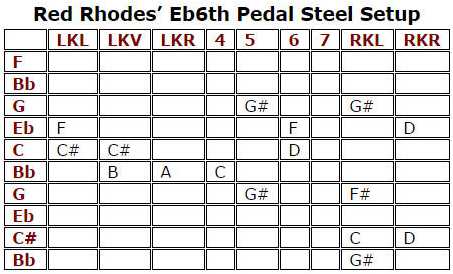
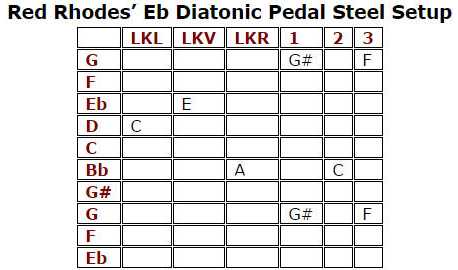
*ABOVE: You can hear Red's unique playing style on his 1979 album titled, “STEEL GUITAR.”
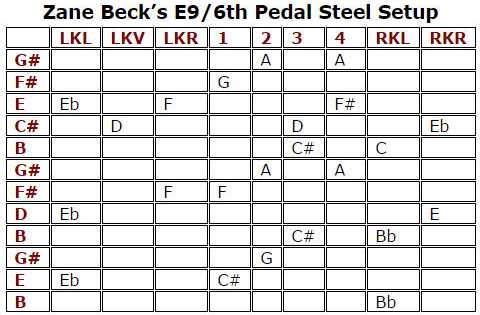
*ABOVE: Zane Beck innovated his own beautiful tuning copedent (as seen above). You can hear Zane masterfully play unique tuning in the songs: “When Irish Eyes Are Smiling,” “Have You Ever Been Lonely,” and “Born To Lose"[2]
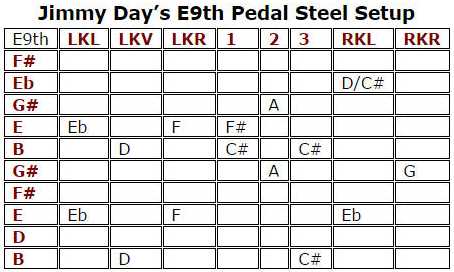
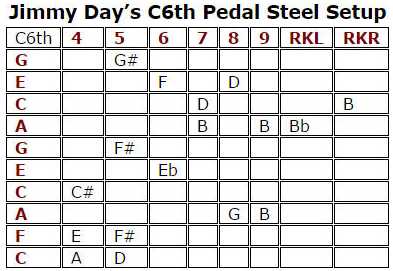
*ABOVE: Jimmy's change on the E9th which raises the B's to D's is very interesting. Also, notice that Jimmy reverses the 1,2 and 3 pedals. This is commonly referred to as the “Day setup” (as verses the “Emmons' setup”).
(MP3, 21:54 minutes long, Texas Steel Show, October 1992)
Major Verses Dominant 7th chords
The following chart below is invaluable. It's a jpeg and you're welcome to download and share it with others. In fact, everything on this website is free for you to share. I use it all the time in studying or figuring out chords and tunings. Something amazing, that I recently learned, and had always wondered, is what's the difference between a Major 7th and a Dominant 7th chord? And why do they call it a dominant 7th? I think this is something good to know as a musician, since we use 7th chords all the time.
It's quite easy. Whoever named everything in the music world decided to call the first note of any scale a TONIC. They called the 4th note of the scale a SUB-DOMINANT. And they called the 5th note of any scale a DOMINANT. That's key information to understand why they call it a “dominant 7th” chord. Who knows why someone called a tree a tree, or a cloud a cloud; but this is just music language. So having said that...
In ANY particular scale, if you start at the 5th note (which is the DOMINANT note in the scale) and find your 1-3-5-7flat, then you'll find a natural dominant 7th chord in ANY scale. Pretty neat, huh? By the way, the only difference between a Major 7th and a Dominant 7th is that a dominant 7th note is flatted a half-note. Always, that's just a rule in music. When musicians refer to a 7th chord, they always mean a dominant 7th unless otherwise stated. So take for example the key of F. If you start at the 5th note (i.e., the DOMINANT), then your 1-3-5-flatted7th would be respectively, C- E - G - Bb. Thus, you have a natural C dominant 7th chord occurring in the key of F, beginning with the DOMINANT 5th note. So that's why they call it a “dominant 7th chord.” Every key has a natural dominant 7th chord; and every dominant 7th chord comes from some particular key. The chart below shows all the relationships. If none of this makes any sense to you, it's ok, just remember that a dominant 7th means to flat the 7th note a half-tone.
Nothing has been changed in the following chord chart. So for the key of C we find that the 7th note is a B note. So we flat it to a Bb to give us a C dominant 7th chord. Take a look at the key of F though and you'll find, starting at the 5th (DOMINANT) note, that the 7th note from there is already flatted for us to Bb. It's a naturally occurring C dominant 7th chord in the key of F. Again, that's why they call it a dominant 7th chord, i.e., because it is found in a scale that begins on the 5th (or DOMINANT) note of any particular scale.
Music Chord Structure Study Chart
And always remember to C# or you'll Bb!
Ralph Mooney's Unique Pedal Steel Copedent
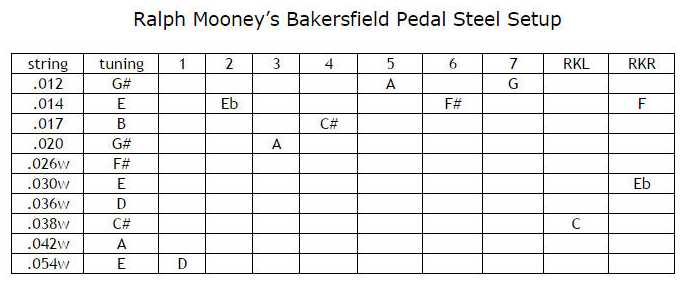
Above: In the song “Rainy Day Woman” (YouTube video) by Waylon Jennings you can see Ralph Mooney in Action. Ralph converted his lower C6th neck into what you see above.